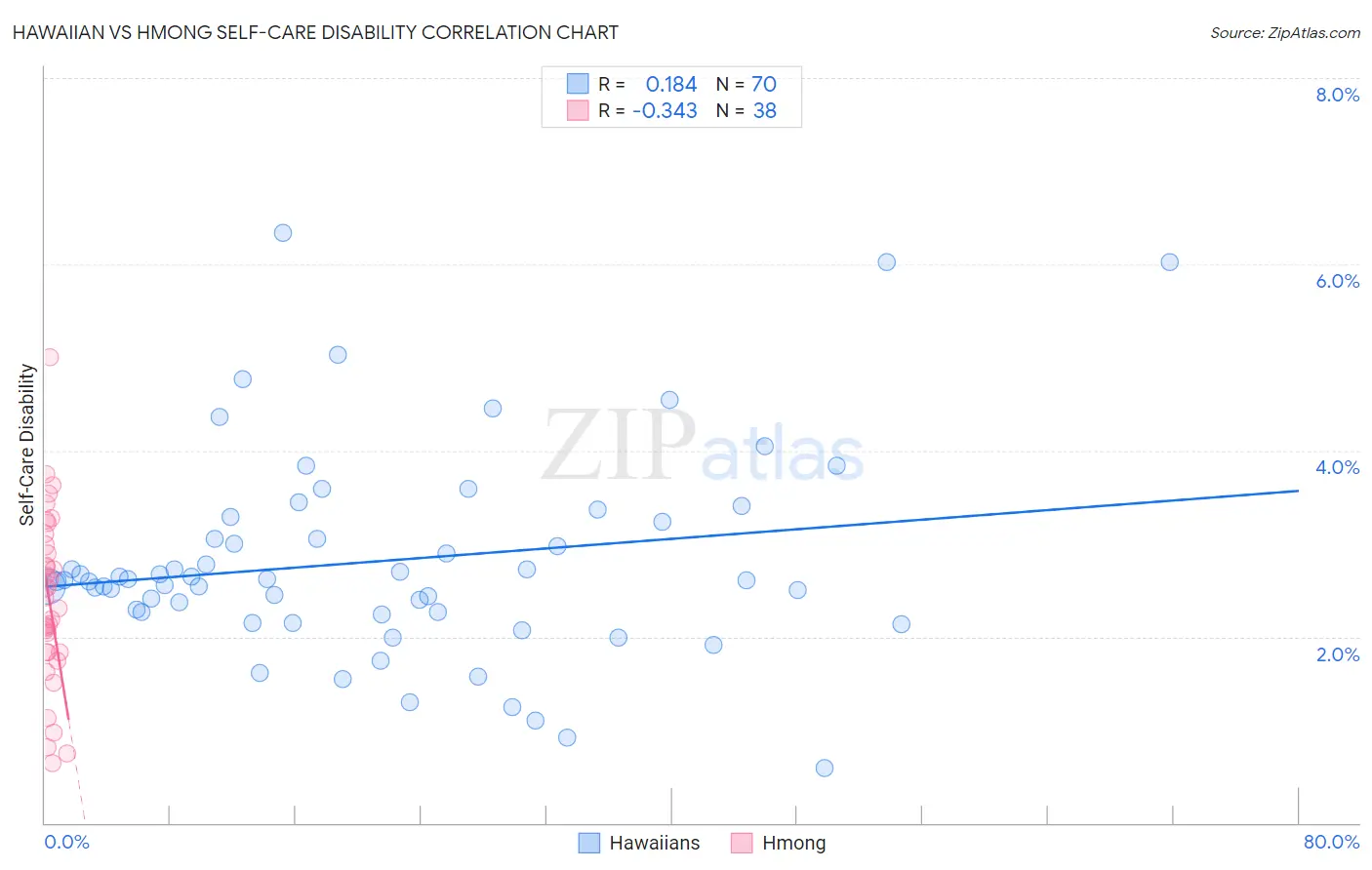Hawaiian vs Hmong Self-Care Disability
COMPARE
Hawaiian
Hmong
Self-Care Disability
Self-Care Disability Comparison
Hawaiians
Hmong
2.6%
SELF-CARE DISABILITY
0.8/ 100
METRIC RATING
243rd/ 347
METRIC RANK
2.4%
SELF-CARE DISABILITY
89.9/ 100
METRIC RATING
126th/ 347
METRIC RANK
Hawaiian vs Hmong Self-Care Disability Correlation Chart
The statistical analysis conducted on geographies consisting of 327,105,730 people shows a poor positive correlation between the proportion of Hawaiians and percentage of population with self-care disability in the United States with a correlation coefficient (R) of 0.184 and weighted average of 2.6%. Similarly, the statistical analysis conducted on geographies consisting of 24,680,008 people shows a mild negative correlation between the proportion of Hmong and percentage of population with self-care disability in the United States with a correlation coefficient (R) of -0.343 and weighted average of 2.4%, a difference of 8.6%.

Self-Care Disability Correlation Summary
| Measurement | Hawaiian | Hmong |
| Minimum | 0.59% | 0.65% |
| Maximum | 6.3% | 5.0% |
| Range | 5.8% | 4.4% |
| Mean | 2.8% | 2.4% |
| Median | 2.6% | 2.4% |
| Interquartile 25% (IQ1) | 2.3% | 1.8% |
| Interquartile 75% (IQ3) | 3.2% | 3.0% |
| Interquartile Range (IQR) | 0.97% | 1.1% |
| Standard Deviation (Sample) | 1.1% | 0.92% |
| Standard Deviation (Population) | 1.1% | 0.91% |
Similar Demographics by Self-Care Disability
Demographics Similar to Hawaiians by Self-Care Disability
In terms of self-care disability, the demographic groups most similar to Hawaiians are Yuman (2.6%, a difference of 0.040%), Spanish (2.6%, a difference of 0.070%), Immigrants from Western Asia (2.6%, a difference of 0.23%), Cheyenne (2.6%, a difference of 0.25%), and Immigrants from Syria (2.6%, a difference of 0.31%).
| Demographics | Rating | Rank | Self-Care Disability |
| Bermudans | 1.9 /100 | #236 | Tragic 2.6% |
| Immigrants | Senegal | 1.6 /100 | #237 | Tragic 2.6% |
| Senegalese | 1.3 /100 | #238 | Tragic 2.6% |
| Immigrants | Panama | 1.2 /100 | #239 | Tragic 2.6% |
| Marshallese | 1.2 /100 | #240 | Tragic 2.6% |
| Immigrants | Syria | 1.0 /100 | #241 | Tragic 2.6% |
| Spanish | 0.8 /100 | #242 | Tragic 2.6% |
| Hawaiians | 0.8 /100 | #243 | Tragic 2.6% |
| Yuman | 0.8 /100 | #244 | Tragic 2.6% |
| Immigrants | Western Asia | 0.6 /100 | #245 | Tragic 2.6% |
| Cheyenne | 0.6 /100 | #246 | Tragic 2.6% |
| Immigrants | Albania | 0.6 /100 | #247 | Tragic 2.6% |
| Nicaraguans | 0.6 /100 | #248 | Tragic 2.6% |
| Mexican American Indians | 0.5 /100 | #249 | Tragic 2.6% |
| Portuguese | 0.4 /100 | #250 | Tragic 2.6% |
Demographics Similar to Hmong by Self-Care Disability
In terms of self-care disability, the demographic groups most similar to Hmong are Colombian (2.4%, a difference of 0.030%), Immigrants from Morocco (2.4%, a difference of 0.040%), Immigrants from North America (2.4%, a difference of 0.040%), Immigrants from Hungary (2.4%, a difference of 0.040%), and Immigrants from Nigeria (2.4%, a difference of 0.050%).
| Demographics | Rating | Rank | Self-Care Disability |
| Immigrants | Sierra Leone | 91.8 /100 | #119 | Exceptional 2.4% |
| Uruguayans | 91.5 /100 | #120 | Exceptional 2.4% |
| Peruvians | 91.3 /100 | #121 | Exceptional 2.4% |
| Belgians | 90.9 /100 | #122 | Exceptional 2.4% |
| Immigrants | Nigeria | 90.3 /100 | #123 | Exceptional 2.4% |
| Immigrants | Morocco | 90.2 /100 | #124 | Exceptional 2.4% |
| Immigrants | North America | 90.2 /100 | #124 | Exceptional 2.4% |
| Hmong | 89.9 /100 | #126 | Excellent 2.4% |
| Colombians | 89.7 /100 | #127 | Excellent 2.4% |
| Immigrants | Hungary | 89.6 /100 | #128 | Excellent 2.4% |
| Immigrants | Romania | 89.3 /100 | #129 | Excellent 2.4% |
| Immigrants | Austria | 89.0 /100 | #130 | Excellent 2.4% |
| Poles | 88.9 /100 | #131 | Excellent 2.4% |
| Immigrants | South America | 88.8 /100 | #132 | Excellent 2.4% |
| Immigrants | Colombia | 88.5 /100 | #133 | Excellent 2.4% |